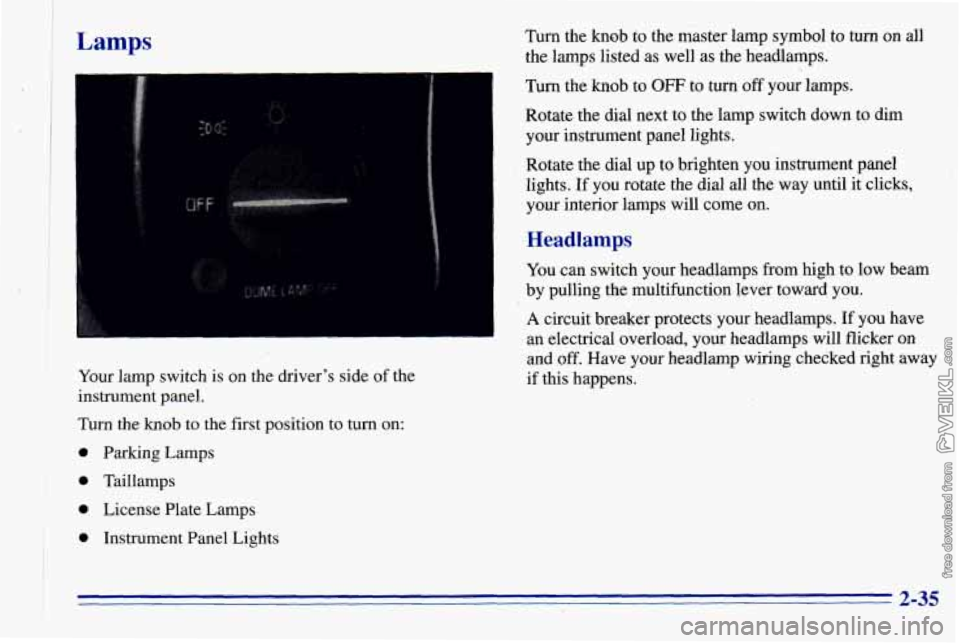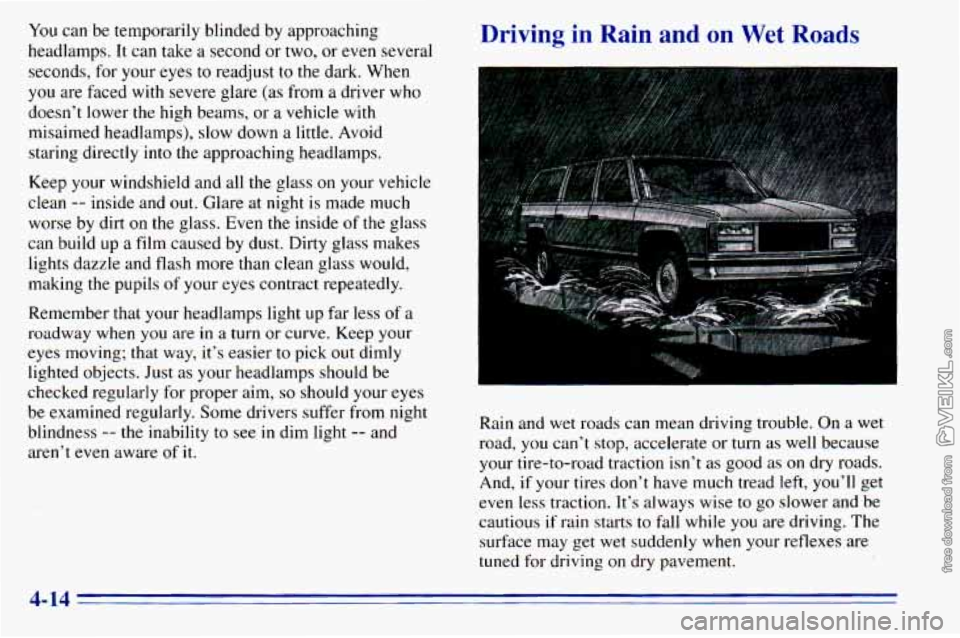1996 CHEVROLET ASTRO high beam
[x] Cancel search: high beamPage 89 of 372

Horn
To sound the horn, press the horn symbols on the
steering wheel.
Tilt Wheel (Option)
Turn' SignaVMultifunction Lever
A tilt steering wheel allows you to adjust the steering
wheel before you drive.
You can also raise it to the highest level to give your
legs more room when you exit and enter the vehicle.
I ' The lever on the driver's side of the steering column
includes your:
0 Turn and Lane Change Signals
0 Headlamp High/Low Beam Changer
0 Windshield Wipers
0 Windshield Washer
To tilt t& wheel, hold the steering wheel and pull the ' 0 Cruise Control (Option)
j lever. Move the steering wheel to a comfortable level,
I then release the lever to lock the wheel in place. I
2-29
Page 90 of 372

Turn and Lane Change Signals
The turn signal has two upward (for right) and two
downward (for left) positions. These positions allow you
to signal a turn or a lane change.
To signal
a turn, move the lever all the way up or down.
When the
turn is finished, the lever will return automatically.
A
An arrow on the instrument
panel will flash in
the
direction of the turn or
lane change.
To signal a lane change, just raise or lower the lever
until the arrow starts to flash. Hold it there until
you
complete your lane change. The lever will return by
itself when you release
it.
As you signal a turn or a lane change, if the arrows don’t
flash
but just stay on, a signal bulb may be burned out
and other drivers won’t see your turn signal.
If a bulb is burned out, replace it to help avoid an
accident. If the arrows don’t go on at all when you
signal a turn, check the fuse (see “Fuses and Circuit
Breakers” in the Index) and for burned-out bulbs.
If you have a trailer towing option with added wiring for
the trailer lamps,
a different turn signal flasher is used.
With this flasher installed, the signal indicator will flash
even if a turn signal bulb is burned out. Check the front
and rear turn signal lamps regularly to make sure they
are working.
Headlamp High/Low Beam Changer
To change the headlamps from low beam to high or high
to low, pull the multifunction lever all the way toward
you. Then release it.
When the high beams are
on, this indicator light on
the instrument panel also
will be on.
2-30
Page 95 of 372

1-
,
Lamps
I
I i
i
I
Turn the knob to the master lamp symbol to turn on all
the lamps listed as well as the headlamps.
Turn the
knob to OFF to turn off your lamps.
Rotate the dial next to the lamp switch down to dim
your instrument panel lights.
Rotate the dial up to brighten you instrument panel
lights. If you rotate the dial all the way until it clicks,
your interior lamps will come on.
Headlamps
You can switch your headlamps from high to low beam
by pulling the multifunction lever toward you.
A circuit breaker protects your headlamps. If you have
an electrical overload, your headlamps will flicker on
and off. Have your headlamp wiring checked right away
I Your lamp switch is on the driver's side of the if this happens.
instrument panel.
Turn the
knob to the first position to turn on:
I 0 'parking Lamps ! 0 Taillamps
I * * License Plate Lamps
0 Instrument Panel Lights
* 2-35
Page 168 of 372

You can be temporarily blinded by approaching
headlamps. It can take a second or two, or even several
seconds, for your eyes
to readjust to the dark. When
you are faced with severe glare (as from a driver who
doesn’t lower the high beams,
or a vehicle with
misaimed headlamps), slow down a little. Avoid
staring directly into the approaching headlamps.
Keep your windshield and all the glass
on your vehicle
clean
-- inside and out. Glare at night is made much
worse by dirt
on the glass. Even the inside of the glass
can build up a film caused by dust. Dirty glass makes
lights dazzle and flash more than clean glass would,
making the pupils
of your eyes contract repeatedly.
Remember that your headlamps light up far less of a
roadway when you are in a turn or curve. Keep your
eyes moving; that way, it’s easier to pick out dimly
lighted objects. Just as your headlamps should be
checked regularly for proper aim,
so should your eyes
be examined regularly. Some drivers suffer from night
blindness
-- the inability to see in dim light -- and
aren’t
even aware of it.
Driving in Rain and on Wet Roads
L
Rain and wet roads can mean driving trouble. On a wet
road, you can’t stop, accelerate or turn as well because
your tire-to-road traction
isn’t as good as on dry roads.
And,
if your tires don’t have much tread left, you’ll get
even
less traction. It’s always wise to go slower and be
cautious
if rain starts to fall while you are driving. The
surface may get wet suddenly when your reflexes are
tuned for driving on dry pavement.
4-14
Page 296 of 372

Replacement Bulbs
Exterior Lamps
Halogen Headlamps - Sealed Beam
Halogen Headlamps
- Composite
Halogen Headlamps
- Composite
Parking, Turn Signal Lamps
Rear Stoplamps
Sidemarker Lamps
Back-up Lamps
Quantity
2
2
2
2
2
4
2
Trade No.
H6054
9006 (Low Beam)
9005 (High Beam)
3 157NA
2057
194
1156
6-66
Page 364 of 372

Finish Damage ................................. 6-56
First Gear
..................................... 2-20
Flashers. Hazard Warning
......................... 5-1
Flat Tire. Changing ............................. 5-23
Fluid Capacities
................................ 6-67
Fluids and Lubricants
............................ 7-47
Foreign Countries. Fuel
........................... 6-4
French Language Manual
11
Front Axle .................................... 6-24
Front Storage Area
.............................. 2-40
Front Towing
.............................. 5-9. 5- 10
Front Turn Signal Lamp Bulb Replacement .......... 6-40
Fuel
.......................................... 6-3
Canada
...................................... 6-3
Filling Your Tank
.............................. 6-5
Gage
....................................... 2-63
In Foreign Countries
........................... 6-4
Regulator
................................... 2-16
Fuses
and Circuit Breakers ....................... 6-61
Gages
.. ...........................
Engine Coolant Temperature .................... 2-62
Engine Oil Pressure
........................... 2-60
Fuel
....................................... 2-63
Garage Door Opener
............................ 2-43
Gear Positions. Automatic Transmission
............. 2- 18
GloveBox .................................... 2-40
Gross Axle Weight Rating
........................ 4-26
Gross Vehicle Weight Rating
...................... 4-26
Guide en FranGais
11
GVWR ....................................... 4-26
GAWR
....................................... 4-26
.. .................................
Halogen
Bulbs ................................ 6-36
Hatch Release
.................................. 2-11
Hazard Warning Flashers .......................... 5-1
Head Restraints ................................. 1-5
Headlamps .................................... 2-35
Bulb Replacement
............................ 6-36
Highkow Beam Changer
...................... 2-30
OnReminder
................................ 2-36
Wiring
..................................... 6-60
Hearing Impaired. Customer Assistance
.............. 8-3
Heating ........................................ 3-5
High-Beam Headlamps
.......................... 2-30
Highway Hypnosis
.............................. 4-20
Hill and Mountain Roads
......................... 4-20
Hitches. Trailer
................................. 4-32
Hood Checking Things Under
......................... 6-7
Prop
....................................... 6-10
Release
...................................... 6-8
Horn
......................................... 2-29
Hydroplaning
.................................. 4-16
Ignition Positions
.............................. 2-14
Inflation. Tire
.................................. 6-43
Inside Daymight Rearview Mirror
................. 2-38
Inspections
.................................... 7-45
Brakesystem
................................ 7-46
Drive Axle
.................................. 7-46
Exhaust Systems
............................. 7-45
Radiator and Heater Hose
...................... 7-45
Steering
.................................... 7-45
Suspension
.................................. 7-45
Throttle Linkage
.............................. 7-45
9-4